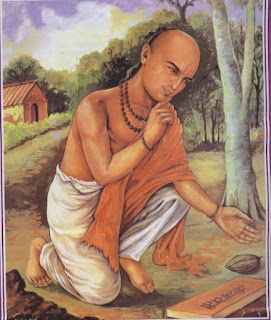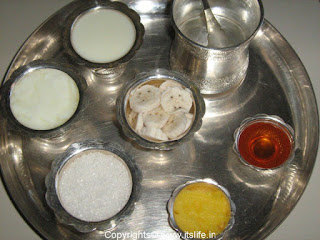"Sahasra yuga paryantam ahar yad brahmano viduh ratrim yuga sahasrantamte ho ratra vido janah"
By human calculation, a thousand ages taken together is the duration of Brahma's one day. And such also is the duration of his night. Since theory of Relativity is complex let us understand this through mythological story.
One of the very first time travel stories recorded in history appears in the Hindu epic Mahabharata, speculated to be written as early as 400 BC.
The story follows a king Kakudmi, his daughter Revati, and their search for a perfect suitor. Kakudmi humbly bowed and made his request to Lord Brahma:
O Brahma! To whom sahall I betroth this daughter? I have searched for many princes and seen also a good many of them and none of them is to my liking and so my mind is not at rest. Brahma laughed at the foolishness of the king. Brahma said o king! The Prince that you thought would become the bridegroom of your daughter, all died; their sons and grandsons and their friends even have all passed away. Brahma goes on to explain, time runs differently on different planes of existence. During the time they had waited in Brahmaloka to see him, 27 chatur yugas , had passed onearth, everything that kakudmi had and owned, his friends and family, his sons and wife, his armies and treasures, had vanished with the time that had passed. The king and his daughter were overcome with astonishment and grief for everything they had lost, but Brahma comforted them, and recommended a worthy husband currently on earth: Balarama, the twin brother of Krishna.
Is this because the plane or abode of the creator was only to be inhabited at a higher speed much higher than the speed of light?
Is it possible that srimad Bhawata was actually referring to a phenomenon that Einstein later came to in his Theory of Relativity and the effects of Travel at or over the speed of light.
Were king Kakudmi and his daughter two unwitting time travellers? What they thought were just minutes in front God Brahma. Millennia had taken place at home. When they came back from Brahmaloka, they did so to a vastly different place.
What is really interesting though, is how similar their view of time was 2500 years ago to how Physics and aAstronomers conceptualize space- time today.
In the theory of Relativity as proposed by Albert Einstein, this is relative to the observers frame of reference. It depends on the observers motion and strength of gravity. For instance one could argue that time here on earth runs slower than in space because gravity slows the passage of time. In the sane way that Einstein says time is relative to the observers frame of reference. It depends on the observers motion and strength of gravity, Brahma tells the father and daughter 2500 years before Einstein was even born that, time runs differently on different planes of existence. That is, during the time they had waited in Brahmaloka to see Brahma 27 chatur yugas had passed on earth.
By human calculation, a thousand ages taken together is the duration of Brahma's one day. And such also is the duration of his night. Since theory of Relativity is complex let us understand this through mythological story.
One of the very first time travel stories recorded in history appears in the Hindu epic Mahabharata, speculated to be written as early as 400 BC.
O Brahma! To whom sahall I betroth this daughter? I have searched for many princes and seen also a good many of them and none of them is to my liking and so my mind is not at rest. Brahma laughed at the foolishness of the king. Brahma said o king! The Prince that you thought would become the bridegroom of your daughter, all died; their sons and grandsons and their friends even have all passed away. Brahma goes on to explain, time runs differently on different planes of existence. During the time they had waited in Brahmaloka to see him, 27 chatur yugas , had passed onearth, everything that kakudmi had and owned, his friends and family, his sons and wife, his armies and treasures, had vanished with the time that had passed. The king and his daughter were overcome with astonishment and grief for everything they had lost, but Brahma comforted them, and recommended a worthy husband currently on earth: Balarama, the twin brother of Krishna.
Is this because the plane or abode of the creator was only to be inhabited at a higher speed much higher than the speed of light?
Is it possible that srimad Bhawata was actually referring to a phenomenon that Einstein later came to in his Theory of Relativity and the effects of Travel at or over the speed of light.
Were king Kakudmi and his daughter two unwitting time travellers? What they thought were just minutes in front God Brahma. Millennia had taken place at home. When they came back from Brahmaloka, they did so to a vastly different place.
What is really interesting though, is how similar their view of time was 2500 years ago to how Physics and aAstronomers conceptualize space- time today.
In the theory of Relativity as proposed by Albert Einstein, this is relative to the observers frame of reference. It depends on the observers motion and strength of gravity. For instance one could argue that time here on earth runs slower than in space because gravity slows the passage of time. In the sane way that Einstein says time is relative to the observers frame of reference. It depends on the observers motion and strength of gravity, Brahma tells the father and daughter 2500 years before Einstein was even born that, time runs differently on different planes of existence. That is, during the time they had waited in Brahmaloka to see Brahma 27 chatur yugas had passed on earth.























